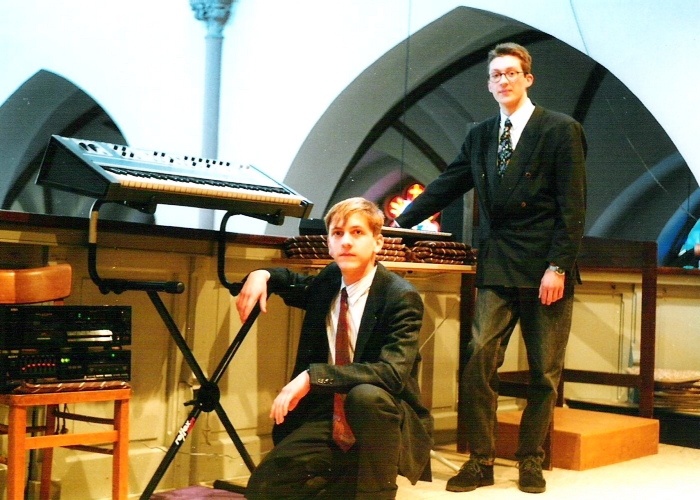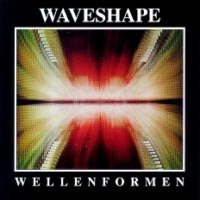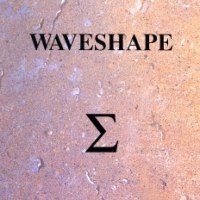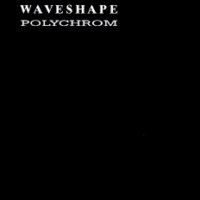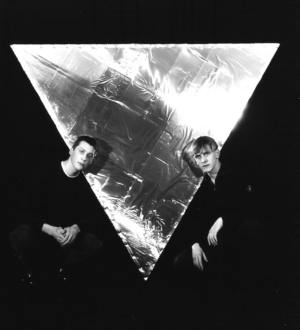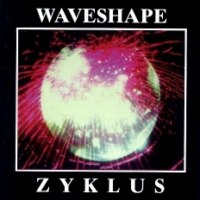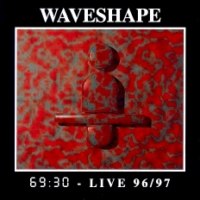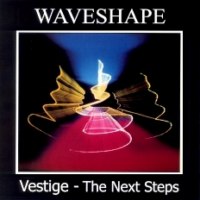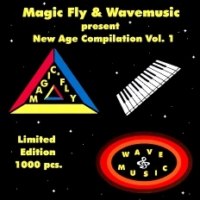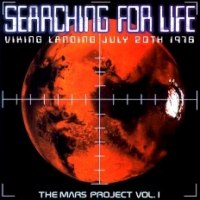
Michael, how did you and Volker meet each other in the beginning of the ’90’s?
Volker and I have known each other since the early 1980s. We went to the same school. Even then we were already interested in natural sciences. In particular chemistry. We attended the same Advanced Course and outside school carried out chemical experiments at home using experimental kits. Together with Ulrich Klein a deep friendship developed. Furthermore, Volker and I attended the Edgar Krause music school in our leisure time. There we learned classic organ play. The music school was also the place where we first came into contact with a synthesizer. A music store was situated in the ground floor of the music school. Here, synthesizers were sold besides classical instruments from 1985 on. Already as a child, I was ardently interested in electronic music as these novel sounds fascinated me. Unfortunately I had to make the detour via accordion and organ before I finally arrived at the synthesizer. A bit of an arduous detour, which admittedly provided me with a rewarding education and qualification. Around 1986 Volker, Ulrich and I started out first musical experiments. Sharing the same musical interests was of course a fortunate coincidence. We had not yet had a joint rehearsal room. We experimented at various places and spent more time with assembling and dismounting the equipment than with playing music. Therefore the call for a studio of our own was getting increasingly louder. In the beginning, a tape recorder, Farfisa rhythm kit, Hohner organ, Yamaha keyboard, EKO K2 bass, Dynachord mixing desk and other antique electronic scrap were used. Volker and I wanted to advance the music project with utmost resolution and to create the necessary preconditions. A permanently present platform which offered us a musical home and a perspective. We took the situation really serious. We fixed up a small house by ourselves which we used as studio from 1990 on and understood as musical sound laboratory henceforth. This is how Waveshape was born.
Would you be so kind to comment on the music and concepts of the albums Waveshape made?
Ok, here we go: “Wellenformen” premiered at the Dutch KLEM-dag in Breda, which was actually our first public appearance outside the Federal Republic of Germany. Initially, this 1992 release was only a limited edition cassette, but in 1996 we released the album on cd. Musically, “Wellenformen” comprises our first musical experiments until 1992.
In the foreground there was not so much a mature logically arranged composition, the album rather projects the ‘adolescent carelessness’ which we then understood as creative sound design.

By current standards, “Wellenformen” sounds astonishingly coarse and rough. Floating shrill sound carpets, strong basses and driving arpeggiators from predominantly analog instruments and continuous loops are forming the profile. The experiment in noise and sound was at the focus. We are telling a story containing only one component: atmosphere. In addition, the album is completely instrumental, leaving the interested listener room to imagine his pictures. As a matter of principal, it has never been our way to deliver our albums with an instruction manual. Surprisingly, the album was rewarded with two rankings in the German radio program Schwingungen”. At a time where the digital era increasingly tried to replace the warm and floating sound of analogue synthesizers. With the album “Wellenformen” we did not present a beautiful melody, but an apparently uncensored audiophile piece of art.
Our next album became the cd “Sigma”, which we in 1993 at Cologne Multimedia Festival at Haus Stollwerk. I can vividly remember how speedily and intuitively we worked on this album.
The individual compositions of this production literally poured out of us. It practically worked on its own. It was our intention to explain to the listener that even a synthesizer must be understood as an independent musical instrument and not as an imitation. In the foreground was a sound which only a synthesizer can produce. As a matter of fact we saw the synthesizer right from the beginning as a creative tool and not as an auxiliary to imitate classical instruments.

Furthermore, it was important to us to create an alternative to the upcoming movement of the so called “New Instrumental Music”, in which soft-boiled melodies or lovely compositions were generated from cold digital sounds.
“Syndon”, “Schwerefeld” and “Schwingende Sphären Teil 1” boycott this genre. We play with tone colors, atmosphere and rhythms, but not with notes and rose-colored change of keys.A lot of what’s heard on “Sigma” is improvised, as the album was also recorded live in the studio. There was only a defined frame of arpeggiators and sequences. Following an effect machine, a Small-Stone Phaser by Electro-Harmonix which was significantly applied in the composition “Sonnenwind”, the cover of our cd should look as if it was carved in stone. And as all compositions on the cd accidentally start with “S” (the Greek sign for “Sigma”), the title of the album was more or less passed on.
Our next album was “Polychrom”, which premiered at the KLEM NRW Festival in 1994 in Lünen. At that time we didn’t know which important step we were undertaking with this album. Numerous fans and journalists praised us and gave us positive feedback. With “Chromosphäre” we had a successful track in our program which was played all over the world or used on various samplers within the second utilization.
“Polychrom” received lots of attention in the international media. Even in Germany, the release was our most successful album so far: after the first release batch, two others followed.

On the production side, a lot of the new things had happened, such as the use of a 3D processor. In order to design our music in the studio more rationally, our fields of activity specialized: Volker took over the audio mix as well as the mastering. I was responsible for the MIDI arrangement and sequencing at the computer. Of course, we created the compositions together and we complemented each other perfectly where needed.
Each composition was examined critically in its formation phase. The numerous sounds which we had all programmed by ourselves were a continuously present source of inspiration.As we always disliked factory presets, we continued our constant search for new sounds. It became such an most important aspect in the composing process it took up at least 50% of our daily work at the studio.

In addition, “Polychrom” was created in cooperation with the Max Planck Institute for Radio Astronomy in Bonn. From them we received original recordings of cosmic radiation, which we implemented in the tracks “Anfang” and “… und Ende”. These recordings allow the listener a look into the past of the universe. For billions of years, cosmological particles have been flying around in the universe. Propelled by the energy of the Big Bang, they enter the earth’s atmosphere even today and with detectors they can be transferred into acoustic signals.
As such it’s an exciting story which attracted our scientific interest. Right from the start we saw the possibilities to the natural sciences (such as e.g. astronomy) and electronic music (such as e.g. “Space Music”). My personal favorites on the album are “Sonnenglanz” and “Corona”, amongst others. They both have this somewhat surreal touch and a certain futuristic note.
This is due to the outstanding nasal tone of the lead sound and the all over set-up of arpeggiator and bass. The final track “… und Ende” is dominated by reduced bass lines and an imposing and seemingly dangerous arpeggiator. Both underline the science fiction-oriented character of this track. We deliberately composed this scenario to engage the listener with this topic for a while, even after the music has faded away.
We presented our fourth release “Zyklus” at the KLEM-dag 1995 in Nijmegen, The Netherlands. I can very well remember this day, because there was a lot stress and excitement in the air. The delivery of the first edition was overdue and the first batch of our new cd reached us only on the same day at 9:30 am. Without even being able to have a closer look at the final product, we packed several boxes into Volker’s Audi and started our trip to Nijmegen. The festival has already started when we arrived at 11:30 am. We heard that several fans had already gathered around our completely empty and undecorated exhibition stall at 10.00. Fortunately, a couple of people offered us support and helped us with setting up our stall. It was a bit of an embarrassing situation. Despite this chaotic start, we were able to sell over 400 copies of our newest album to the fans that day.

Now a bit more about the music: the production of “Zyklus” implemented changes in our studio. He had new synthesizers and effect machines, and a Falcon030 hard disc recording system (Cubase Audio 16) completed our the inventory. The new equipment was piled up in our studio and at first we spent a lot of time with studying the new tools and using their potential for our purposes. Thematically, “Zyklus” saw a continuation of the story we had previously started with “Polychrom” We used original sound recordings of a pulsating neutron star from the constellation Cassiopeia. This pulsar sends rhythmic radiation pulses into the depth of the universe and finally perishes in a gigantic explosion which releases enough matter to create new planetary systems. New worlds replace old ones, or better said, grow from these. Therefore, all the matter which surrounds us consists of the remains of dead stars. A fascinating spectacle. Thus, “Zyklus” describes to a certain extent this eternal substitution process of nature. “Abendstern” (track 8) and “Magma” (track 11) are among my personal favourites of this album. Both have this easy driving pace.
In the final track, “Puls” one can experience a kind of déjà vu, a retrospective of the whole cd in the highest gear.
Our fifth album “69:30 – Live 96/97” includes live recordings of several concerts we played in 1996/1997. I very well recall the “Space Night” concert at “Discotheque PM” in Moers.
At this gig, we presented our Virtual Light Machine to a large audience for the first time. It’s a 64-Bit hardware device which emphasized our music synchronously and optically on a screen in real time. At the start of the event we had distributed around 200 spectral glasses to the audience. These glasses reinforced the optical effect and permitted the visitor to submerge into a pulsating world made of polychromous plasma and fractal images.
Our gig at the EMMA festival in Derby, England, was spectacular in a similar manner, as we were announced as the highlight of the evening.

Musically, “69:30” already contains the first three pieces of our planned album “Vestige” in a non-committal live version. A kind of appetizer so to speak. Next to them one can find a potpourri of our most favorite tracks in a new, improvised style.

What more can you tell on how these releases compare to each other?
Well, the typical cosmic “Waveshape sound” runs like a red thread through all of our records. This sound was determined by the equipment which had been amassed in our studio and the manner in which we used this equipment. As said previously, the whole process demanded a lot of time and dedication, as we had to learn each instrument all by ourselves, also to find out individual place in the whole set-up.
To me, it was always important to use the equipment 100%. This was basic foundation of our work of art. Technology as source of inspiration and continuative tool. Work at the base of electronic music! Thematically and technologically we were always true to our natural scientific streak. The constant search for new sounds and creative design elements within the compositions were the driving force of our creation. I always describe Waveshape’s music as “classic/traditional electronic music”. The term “Berliner Schule” doesn’t mean anything to the masses.
It has always been our goal to combine music and science on an artistic level.
Beside the albums, were there any unique tracks released by Waveshape? And if so, where can these be found?
Yes, there are. You can find exclusive music by Waveshape on the following compilations:
“Sequences Music Magazine Vol.10”
© 1994 Mick Garlick, United Kingdom
Track No.12 – “Unreleased Track”
Style: Chill-Out, Berliner Schule

“Magic Fly & Wavemusic present: New Age Compilation Vol.1”
© 1995 Motionmania Music, Germany
Track No.5 – Spektral II (Remix 95)
Style: Chill-Out, Berliner Schule

“Searching For Life – The Mars Project Vol.1”
© 1996 CUE Records, Germany
Track No.8 – Abendstern (Remix 96)
Style: Ambient, Chill-Out, Trance
Furthermore, we got also involved in the field of commissioned productions and functional music. At first our interest was directed towards the design and realization of custom compilations. Altogether several tracks and soundtracks were created, which were not released under the name Waveshape.
We worked as independent music publishers and serviced numerous utilization channels with exclusive licensed productions. Our licensees included e.g. MMP Multimedia Project, MAP TV- & Video-Produktion as well as SAM Sound Around Music.
In addition, we were content provider for Deutsche Telekom Berkom AG’s MOD Music-On-Demand for several years.
What more can you tell about the Waveshape’s live concerts?
Waveshape gave several concerts and there was the previously mentioned live album. We e.g. played:
*”Waveshape Live”, Pfarrkirche St. Patricius, Eitorf, Germany, 29 December 1992
*”Kunst & Kulturtage”, Theater am Park, Eitorf, Germany, 28 September 1996 to 6 October 1996
*”Space Night”, Discothek PM, Moers/Essen, Germany, 17 November 1996
* “EMMA Festival”, Assembly Rooms, Derby, United Kingdom, 31 May 1997
From August to September 1998, we also played on the live stage of PopKomm Music Convention in Cologne as well as in hip clubs of Cologne’s electronic music scene, e.g. “Discothek Visions” or “Club Lucky B”.
That tour had been organized in cooperation with “Proof Productions Cologne”. Karsten Erdmann from June Audio coordinated our PopKomm campaign. Furthermore, we had a presentation at the “Science-Fiction-Tage-NRW” in Dortmund in Spring 1998, which had been realized in cooperation with Beluga Post.
In 1998, you and Volker made the album “Rückkehr der kosmischen Kuriere”, using the moniker Arkos. How did this concept album come about?
Well, Volker and I had regular contact to the Science Fiction scene as we felt a certain affinity for it which corresponds extremely well with our cosmic space sound. In our views, electronic music, astronomy and science fiction are somehow connected: electronic music creates the appropriate ambience for such topics. With the side project Radium, we wanted to effect a reorientation of the market and a fusion of the related special interest groups. Waveshape on the other hand is a form of expression which starts with excluding the commercial aspect altogether and offers us an artistic home. In the beginning we wanted to set the “Captain Future” revival to music. Here we were confronted with a rather untransparent mesh of trademark and copyright related bureaucracy. The realization of our idea was furthermore hindered by the existence of various “Captain Future” remixes, which were already circulating besides the original soundtrack by Christian Bruhn. Finally, all plans ended with the idea and realization to try and create a character of our own. In doing so, we didn’t have to overcome bureaucratic obstacles and had an unhindered scope of going back and forth in every aspect. We announced a competition in a well-known fanzine of the Sci-Fi scene. The contestants were to draw a comic for us. As a start, we provided a roughly sketched background story. Christiane Lieke handed in the best design. She was the winner of the “Arkos Comic Competition”. Her comic was used for our booklet.
We were inspired by the story, so we arranged the music like a movie soundtrack. Volker contributed further drawings and graphics as well as all accompanying texts. I designed the cover picture and the Raytrace animations contained in the booklet. Photographer Rainer Tonn, with whom two shootings were arranged in Linz and Bonn, took some portraits which were used in photomontages. Afterwards, all components were tied together to a creative overall package in an A5 big box format. The first part of our Sci-Fi trilogy was finished and had taken up a developing period of approximately two years.
Radium Arkos 1 – Rückkehr der Kosmischen Kuriere” premiered on 14 August 1998 at PopKomm Music Convention in Cologne. Some of the attending journalists constructed a connection between our cd title and the pioneers of the “Berliner Schule”, who had called themselves “Kosmische Kuriere” and who had emerged from the politically-motivated “Krautrock scene”.
Final question. Between the various Waveshape-releases and after the project was put to an end, you seem to have made a few solo projects as well …
Yes, several releases appeared as limited editions on the Sulu Express label:

Bit-Zone – Contact
Studio album cd [BZ01.2] © 1999 Sulu Express
Style: Arcade, Stakker, Retro
Bit-Zone – Plug Your Joystick In
Studio album cd [BZ02.2] © 2000 – 2004 Sulu Express
Style: Arcade, Stakker, Retro
Heizkoerper – Space Night 2004
Digital Remaster Ep cd [HK01.2] © 2001 – 2004 Sulu Express
Style: Space Music, Trance, Ambient
Heizkoerper – My Fetching Red Firebutton
Sound track cd [HK03.2] © 2004 Sulu Express
Style: Electro, Dance, Space Music
Heizkoerper – Jaunting Pixels On The Screen
Club sound maxi cd [HK03.3] © 2004 Sulu Express
Style: Electro, Dance, Acid
Discography:

* Wellenformen (1991/92)
* Sigma (1993)
* Polychrom (1994)
* Zyklus (1995)
* 69:30 Live (1996/97)
* Vestige: The Next Steps (1999)
As Radium Arkos 1: Ruckkehr der kosmischen Kuriere |
